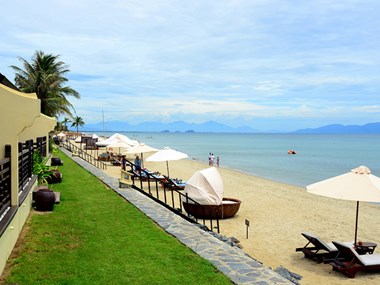
Vietnam has most affordable beaches in the world, according to TravelBird, a Netherland-based travel company.
TravelBird has released its 2018 Beach
Price Index, which breaks down the daily expenses of a seaside holiday at 327
of the most popular beaches in over 90 countries around the globe to reveal
which destination offer the best value for money.
It looked at the price of six popular beach purchases, including the cost of
sunscreen, a bottle of water, a beer, an ice cream, lunch, and facility fee, at
each destination. The facility fee covers any potential entrance fee to the
beach, in addition to the cost of renting a sun lounger, or a beach chair, and
an umbrella for one day.
These figures are based on statistics by local tourism agencies and data from
the World Tourism Organisation (UNWTO).
According to the rankings, Vietnam
came first for cheapest beach holidays, while the world’s most expensive ones
are found in the Pacific region and Italy.
Of all the beaches, the three cheapest spots are in Vietnam – Cua Dai Beach in
Hoi An Ancient Town, the central province of Quang Nam (13.44 EUR for all six
items); City Beach in Nha Trang city, the south central province of Khanh Hoa
(14.47 EUR); and Long Beach in Phu Quoc, the resort island of the Mekong Delta
province of Kien Giang (16.03 EUR).
Cua Dai Beach,
which is 7.6km long and about 5km from Hoi An's old quarter, is a popular
destination for tourists visiting the ancient city. It costs a holidaymaker
about 2.07 EUR for 200ml of SPF 30 sunscreen bottle from a local store; 0.37
EUR for a 500ml bottle of water, 1.6 EUR for a bottle of beer and 0.87 EUR for
an ice cream on the beach.
Meanwhile, lunch, including a drink and dessert for one person from a beach bar
or the closet establishments to the beach, typically cost an average of 7.43
EUR and facility fee is at 1.10 EUR in average.
The beach was also named the world’s cheapest by TravelBird in 2016 and 2017.
For the most expensive, beach-goers must pay a total of 78.57 EUR for all six
items in Anse Vata Beach in Noumea, New Caledonia, a special collectivity of
France in the southwest Pacific Ocean. It is followed by Finale Ligure, Liguria in Italy
(76.59 EUR) and Yonaha Maehama Beach,
Okinawa in Japan
(70.32 EUR).
Source: VNA
A diverse chain of eco-tourism and resort destinations concentrated in Hoa Binh city and the districts of Tan Lac, Da Bac, and Luong Son… Along with the launch of several key high-quality resort tourism projects, these developments have reshaped the landscape and enhanced the appeal of Hoa Binh as a travel destination.
Boasting diverse terrain, a mild climate, and rich natural resources, Cao Phong district is increasingly asserting its place on Vietnam’s tourism map, attracting both domestic and foreign visitors. The district is renowned for its stunning landscapes, majestic mountains, a crystal-clear hydropower lake, and the unique cultural identity of local ethnic groups.
With its pristine landscapes, unique cultural heritage of Muong ethnic minority, and an expanding range of visitor experiences, Tan Lac district of Hoa Binh has fast become a captivating destination for both domestic and international tourists.
Until now, Sung village in Cao Son commune, Da Bac district remains the only Dao ethnic community in Hoa Binh province to develop a community-based tourism model. Beyond its untouched natural landscapes, cultural identity serves as the cornerstone attraction for visitors.
Alongside the diverse cultural identities of the Kinh, Muong, Tay, Thai, Dao, and Mong ethnic people, Hoa Binh province is also renowned as the "capital" of the northwestern Vietnamese cuisine, offering unique and distinctive dishes. At festivals, during Lunar New Year (Tet), or on significant family or community occasions, special dishes are prepared, leaving a lasting impression on visitors.
A Phong Linh (Yellow Tabebuia) flower garden in Thang village, Thach Yen commune, Cao Phong district is currently in full bloom, drawing a large number of visitors.



